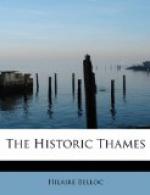Consider Chertsey, from which Bisham sprang. The utter dispersion of the whole tradition of Chertsey is more violent than that perhaps of any other historical site in England. The Crown maintained, as we have seen to be the case elsewhere, its nominal hold upon the foundations of the abbey and of what was left of the buildings, though that hold was only nominal, and it maintained such a position until 1610—that is, for a full lifetime after the community was dispersed. But the tradition created by FitzWilliam continued, and the Crown was ready to sell at that date, to a certain Dr. Hammond. The perpetual mobility which seems inseparable from spoils of this kind attaches thenceforward to the unfortunate place. The Hammonds sell after the Restoration to Sir Nicholas Carew, and before the end of the seventeenth century the Carews pass it on to the Orbys, and the Orbys pass it on to the Waytes. The Waytes sell it to a brewer of London, one Hinde. So far, contemptuous as has been the treatment of this great national centre, it had at least remained intact. With Hinde’s son even that dignity deserted it. He found it advisable to distribute the land in parcels as a speculation; the actual emplacement of the building went to a certain Harwell, an East Indian, in 1753, and his son left it by will to a private soldier called Fuller, who was suspected of being his illegitimate brother. Fuller, as might be expected, saw nothing but an opportunity of making money. He redivided what was left intact of the old estate, and sold that again by lots in 1809; a stockbroker bought the remaining materials of a house whose roots struck back to the very footings of our country, sold them for what they were worth—and there was the end of Chertsey.




